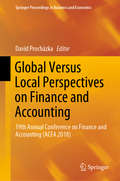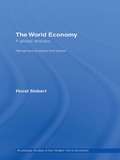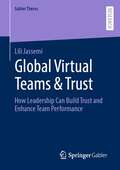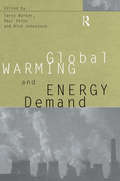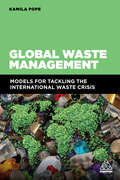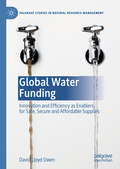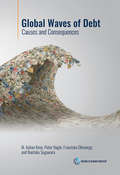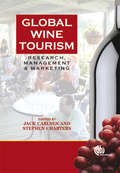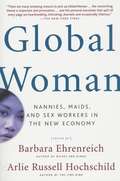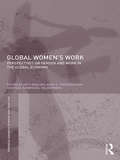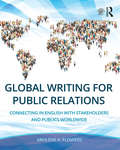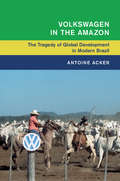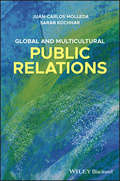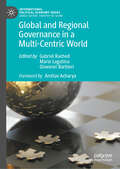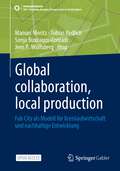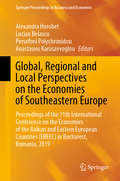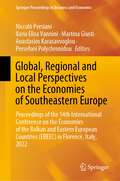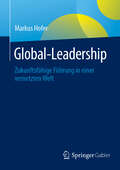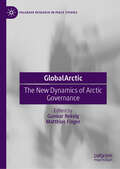- Table View
- List View
Global Value Creation: The ADDING Value Scorecard
by Pankaj GhemawatThis chapter discusses why firms should globalize in a world in which distance still matters, presenting a scorecard for tracking value creation that includes but goes beyond the familiar components of size and economies of size. This chapter was originally published as chapter 3 of "Redefining Global Strategy: Crossing Borders in a World Where Differences Still Matter."
Global Versus Local Perspectives on Finance and Accounting: 19th Annual Conference on Finance and Accounting (ACFA 2018) (Springer Proceedings in Business and Economics)
by David ProcházkaThis proceedings volume examines accounting and financial issues and trends from both global and local economic perspectives. Featuring selected contributions presented at the 19th Annual Conference on Finance and Accounting (ACFA) held in Prague, Czech Republic, this book offers a mixture of research methods and micro- and macroeconomic approaches to depict a detailed picture of the impact of global and local determinants on the globalized economy. The global perspectives versus local specifics make the volume useful for not only academics and scholars, but also for regulators and policy makers when deliberating the potential outcome of competing regulatory mechanisms.The Annual Conference on Finance and Accounting (ACFA) has become one of the biggest conferences in the Central and Eastern European (CEE) region solely oriented to contemporary research in finance and accounting. Bringing together researchers and scholars from all over the world, the conference provides a platform in which thoughts, visions, and contemporary developments in the field of finance and accounting are discussed.
Global View on the World Economy: A Global Analysis (Routledge Studies in the Modern World Economy)
by Horst SiebertAs globalization continues apace, market segmentations are diminishing, distance is shrinking and the boundaries between nation states are becoming increasingly blurred. National economies are closely interlinked through manychannels and we rarely view things from a single country’s view, adopting a global perspective instead. It is therefore imperative to understand how the world economy functions. This book utilizes up to date empirical evidence to illuminate the mechanics of the world as a single entity. The author explores the properties of the world economy, the diverse mechanisms of interdependence, shocks and disturbances, economic processes and structures, and the institutional arrangements that guide these processes. Key topics covered include: world GDP, growth and global product and factor markets China as a new global player the roots and impact of financial and currency crises the performance of the developing countries over time (which have gained, which have lost?) conflicts between the national interest and global concerns (protectionism, locational competition for mobile factors of production, environmental issues) the institutional arrangements for the world economy (IMF, WTO). The World Economy: A Global Analysis will be essential reading for students studying the world economy from the perspective of economics, finance, business and politics.
Global Virtual Teams & Trust: How Leadership Can Build Trust and Enhance Team Performance (Gabler Theses)
by Lili JassemiGlobal virtual teams have become essential in any organization in the past decade, but communication, cultural, and coordination issues often affect their performance. Trust is essential for team success, especially in global virtual teams. This book explores how leadership can establish and maintain trust in global virtual teams to improve cooperation and performance. It suggests that leaders should invest in trust by realizing the ethical focal point ‘do no (illegitimate) harm’ realized by showing respect, providing orientation, setting framework conditions, and acting as role models with trustworthy behavior and consistent communication.
Global Warming and Energy Demand (Global Environmental Change Ser.)
by John Houghton Paul Ekins Nick Johnstone Terry BarkerThis book presents a range of current views on the use of economic measures to control greenhouse gas emissions. the authors discuss the responsiveness of the energy market to changes in prices, taxes and incomes. The book's concern with global warming involves analyses of possible energy use both in the long and short term.
Global Waste Management: Models for Tackling the International Waste Crisis
by Kamila PopeAmong other factors, rapid global population growth, our development model and patterns of production and consumption have increased waste generation worldwide to unsustainable rates. This rise has led to crises in many countries where waste management practices are no longer sound. Global Waste Management outlines the emerging global waste crisis considering the perspectives of developed and developing countries around the world and the international relationships between them. This book provides an ecological viewpoint as well as studying these problems from a legal and justice standpoint. Global Waste Management contextualises the problems faced when dealing with waste including the causes and origins. Focus is given to cross border waste transfer, as an ongoing and controversial practice, making waste management a global matter. This book scrutinizes existing international, European and Brazilian regulation on waste to highlight the complexity of the subject and the weaknesses of the law. Using a critical and socio-ecological approach, the book proposes an original model of governance to support a new system of global waste management that takes into account ecological sustainability and social justice to overcome the waste crisis. To create these models, a theoretical framework on socio-ecological justice is developed and combined with different discourses and theories described throughout the book. This is the essential guide to understanding the global waste crisis and the future of waste management.
Global Water Funding: Innovation and efficiency as enablers for safe, secure and affordable supplies (Palgrave Studies in Natural Resource Management)
by David Lloyd OwenIs safe and sustainable water and sanitation for all an unaffordable pipedream? This book surveys the worldwide development of water and sewage services and the challenges in meeting Sustainable Development Goal 6 (SDG6) along with climate change, population growth and urbanisation. It explores the reasons why current SDG6 progress is failing, including weak policy implementation, staff shortages and inadequate funding, as well as the limited impact of aid funding. The author contends that despite a series of innovations, debt finance remains too small to address needs of developing economies. Therefore, instead of advocating new funding, this book proposes addressing the funding gap through technological innovation and more efficient management and procurement through a series of examples that have challenged traditional assumptions. After four decades of good intentions, SDG6 is making a difference in monitoring shortfalls for the first time, allowing for more effective responses. This book outlines the role of innovation in hardware development, procurement and installation, and discusses how network management and operations can most effectively address funding gaps. The potential for savings is considerable, if effectively replicated. New approaches are driving forward affordable resilience, including nature-based solutions such as upstream habitat enhancement to retain water and improve downstream water quality; the circular economy, including water, nutrient, energy and heat recovery from wastewater; and demand management. This book will be of great value to scholars, policy makers and practitioners interested in the global finance of sustainable water and sanitation.
Global Waves of Debt: Causes and Consequences
by M. Ayhan Kose Franziska Ohnsorge Peter Nagle SugawaraThe global economy has experienced four waves of rapid debt accumulation over the past 50 years. The first three debt waves ended with financial crises in many emerging market and developing economies. During the current wave, which started in 2010, the increase in debt in these economies has already been larger, faster, and broader-based than in the previous three waves. Current low interest rates mitigate some of the risks associated with high debt. However, emerging market and developing economies are also confronted by weak growth prospects, mounting vulnerabilities, and elevated global risks. A menu of policy options is available to reduce the likelihood that the current debt wave will end in crisis and, if crises do take place, will alleviate their impact.
Global Wine Tourism: Research, Management and Marketing
by Jack Carlsen Stephen ChartersWine regions are attracting increasing numbers of tourists through tours, wine festivals and events, and winery, restaurant and cellar door experiences. Using a host of case studies from Europe, North America, South Africa, Australia and New Zealand this book reviews the latest wine tourism research and management and marketing strategies.
Global Wine War 2009: New World versus Old
by Christopher A. BartlettThe case contrasts the tradition-bound Old World wine industry with the market-oriented New World producers, the battle for the US market, the most desirable export target in 2009 due to its large, fast-growing, high-priced market segments. The case allows analysis of the way in which newcomers can change the rules of competitive engagement in a global industry. It also poses the question of how incumbents can respond, especially when constrained by regulation, tradition, and different capabilities than those demanded by changing consumer tastes and market structures.
Global Wine War 2015: New World Versus Old
by Christopher A. Bartlett Sarah McaraThe case contrasts the tradition-bound Old World wine industry with the market-oriented New World producers in the battle for the Chinese wine market in 2015. China's wine consumption growth presented a large and fast growing export target that was extremely attractive both to Old World producers burdened with oversupply and declining demand, and to New World winemakers faced with rising costs and a deteriorating image. But changing Chinese market conditions and consumer preferences required both sets of players to devise new strategies to gain share in this fast-growing market. The case allows analysis of the way in which newcomers can change the rules of competitive engagement in a global industry. It also poses the question of how incumbents can respond, especially when constrained by regulation, tradition, and different capabilities than those demanded by changing consumer tastes and market structures.
Global Woman
by Arlie Russell Hochschild Barbara Ehrenreich<P>In a remarkable pairing, two renowned social critics offer a groundbreaking anthology that examines the unexplored consequences of globalization on the lives of women worldwide. <P>Women are moving around the globe as never before. But for every female executive racking up frequent flier miles, there are multitudes of women whose journeys go unnoticed. Each year, millions leave Mexico, Sri Lanka, the Philippines, and other third world countries to work in the homes, nurseries, and brothels of the first world. This broad-scale transfer of labor associated with women's traditional roles results in an odd displacement. <P>In the new global calculus, the female energy that flows to wealthy countries is subtracted from poor ones, often to the detriment of the families left behind. The migrant nanny-- or cleaning woman, nursing care attendant, maid-- eases a "care deficit" in rich countries, while her absence creates a "care deficit" back home. <P>Confronting a range of topics, from the fate of Vietnamese mail-order brides to the importation of Mexican nannies in Los Angeles and the selling of Thai girls to Japanese brothels, "Global woman offers an unprecedented look at a world shaped by mass migration and economic exchange on an ever-increasing scale. In fifteen vivid essays-- of which only four have been previously published-- by a diverse and distinguished group of writers, collected and introduced by best selling authors Barbara Ehrenreich and Arlie Russell Hochschild, this anthology reveals a new era in which the main resource extracted from the third world is no longer gold or silver, but love.
Global Women's Work: Perspectives on Gender and Work in the Global Economy (Routledge IAFFE Advances in Feminist Economics)
by Mary E. Frederickson Beth English Olga Sanmiguel-ValderramaThis volume considers how women are shaping the global economic landscape through their labor, activism, and multiple discourses about work. Bringing together an interdisciplinary group of international scholars, the book offers a gendered examination of work in the global economy and analyses the effects of the 2008 downturn on women’s labor force participation and workplace activism. The book addresses three key themes: exploitation versus opportunity; women’s agency within the context of changing economic options; and women’s negotiations and renegotiations of unpaid social reproductive labor. This uniquely interdisciplinary and comparative analysis will be crucial reading for anyone with an interest in gender and the post-crisis world.
Global Writing for Public Relations: Connecting in English with Stakeholders and Publics Worldwide
by Arhlene A. FlowersGlobal Writing for Public Relations: Connecting in English with Stakeholders and Publics Worldwide provides multiple resources to help students and public relations practitioners learn best practices for writing in English to communicate and connect with a global marketplace. Author Arhlene Flowers has created a new approach on writing for public relations by combining intercultural communication, international public relations, and effective public relations writing techniques. Global Writing for Public Relations offers the following features: Insight into the evolution of English-language communication in business and public relations, as well as theoretical and political debates on global English and globalization; An understanding of both a global thematic and customized local approach in creating public relations campaigns and written materials; Strategic questions to help writers develop critical thinking skills and understand how to create meaningful communications materials for specific audiences; Storytelling skills that help writers craft compelling content; Real-world global examples from diverse industries that illustrate creative solutions; Step-by-step guidance on writing public relations materials with easy-to-follow templates to reach traditional and online media, consumers, and businesses; Self-evaluation and creative thinking exercises to improve cultural literacy, grammar, punctuation, and editing skills for enhanced clarity; and Supplemental online resources for educators and students. English is the go-to business language across the world, and this book combines the author's experience training students and seasoned professionals in crafting public relations materials that resonate with global English-language audiences. It will help public relations students and practitioners become proficient and sophisticated writers with the ability to connect with diverse audiences worldwide.
Global and International History: Humanitarian Invasion
by Timothy NunanHumanitarian Invasion is the first book of its kind: a ground-level inside account of what development and humanitarianism meant for Afghanistan, a country touched by international aid like no other. Relying on Soviet, Western, and NGO archives, interviews with Soviet advisers and NGO workers, and Afghan sources, Timothy Nunan forges a vivid account of the impact of development on a country on the front lines of the Cold War. Nunan argues that Afghanistan functioned as a laboratory for the future of the Third World nation-state. If, in the 1960s, Soviets, Americans, and Germans sought to make a territorial national economy for Afghanistan, later, under military occupation, Soviet nation-builders, French and Swedish humanitarians, and Pakistani-supported guerrillas fought a transnational civil war over Afghan statehood. Covering the entire period from the Cold War to Taliban rule, Humanitarian Invasion signals the beginning of a new stage in the writing of international history.
Global and International History: Of Limits and Growth
by Stephen J. MacekuraOf Limits and Growth connects three of the most important aspects of the twentieth century: decolonization, the rise of environmentalism, and the United States' support for economic development and modernization in the Third World. It links these trends by revealing how environmental NGOs challenged and reformed the development approaches of the US government, World Bank, and United Nations from the 1960s through the 1990s. The book shows how NGOs promoted the use of 'appropriate' technologies, environmental reviews in the lending process, development plans based on ecological principles, and international cooperation on global issues such as climate change. It also reveals that the 'sustainable development' concept emerged from transnational negotiations in which environmentalists accommodated the developmental aspirations of Third World intellectuals and leaders. In sum, Of Limits and Growth offers a new history of sustainability by elucidating the global origins of environmental activism, the ways in which environmental activists challenged development approaches worldwide, and how environmental non-state actors reshaped the United States' and World Bank's development policies.
Global and International History: The Tragedy of Global Development in Modern Brazil (Global and International History)
by Antoine AckerFrom 1973 to 1987, Volkswagen's (VW) 140,000 hectare 'pioneer' cattle ranch on the Amazon frontierlaid barethe limits of capitalist development. These limits were not only economic, with the core management of a multinational company engaged in the 'integration' of an extreme world periphery, but they were also legal and ethical, with the involvement of indentured labor and massive forest burning. Its physical limits were exposed by an unpredictable ecosystem refusing to submit to VW's technological arsenal. Antoine Acker reveals how the VW ranch, a major project supported by the Brazilian military dictatorship, was planned, negotiated, and eventually undone by the intervention of internationally connected actors and events.
Global and Multicultural Public Relations: Strategies In Transnational Corporations, Governments, Nongovernmental And Multilateral Organizations, Agencies
by Juan-Carlos Molleda Sarab KochharAn overview of the practice of strategic global and multicultural public relations in various sectors Global and Multicultural Public Relations offers students an expert overview of specific public relations practices, focused on strategic analyses of actual case studies and real-world examples. Emphasizing practice rather than theory, this valuable resource explores innovative communication programs that are designed to address culturally-diverse communities worldwide. The five-step strategic public relations process—formative research, planning, implementation, evaluation, and stewardship—is extensively examined and applied to a variety of scenarios, helping students understand the realty of modern public relations practice. All aspects of public relations practice, including media relations, government relations, employee communications, and shareholder relations are covered to help students gain solid foundational knowledge. Broad in scope, this textbook identifies and describes the strategy formulation and implementation process in private, government, non-profit, and various other sectors. Academic and trade articles, book chapters, original case studies, and new primary research offer students a realistic and sophisticated approach to global public relations. Figures, tables, photographs, and charts illustrate each topic, while highlighted learning objectives and key points, discussion questions, and framed sections on ethical considerations and best practices strengthen student comprehension. Employs a real-world approach to public relations principles, practices, and strategies Focuses on global public relations rather than outdated nation-centered models Fills a gap in current literature on multinational and multicultural public relations Explains the public relations strategies that are best suited for each sector Includes summary sections that contain suggested readings and supplemental online links Designed for upper-level undergraduate and graduate students, Global and Multicultural Public Relations is an ideal textbook for courses in international public relations, global communication, public relations management, and multinational management, as well as business, political sciences, and public administration.
Global and Multinational Advertising
by Basil G. EnglisFew applied disciplines are more sensitive to cross-cultural issues than marketing and consumer psychology. The chapters prepared for this volume reflect awareness of both similarities and differences within and across cultures. They include analyses of methodological issues, theoretical investigations of cultural and social values and their implications for marketing specialists, studies of gender- and sub-culture specific advertising, and investigations of advertising efforts in several different international markets. The scholars and advertising professionals who contributed these chapters will have much to say to consumer psychologists and marketing specialists alike.
Global and Regional Governance in a Multi-Centric World (International Political Economy Series)
by Maria Lagutina Gabriel Rached Giovanni BarbieriIn a world shaken by constant crises and shifting power dynamics, Global and Regional Governance in a Multicentric World delves into the core of the global governance system, exploring its flaws, its evolution, and the forces seeking to reshape it. As the Western-crafted liberal order faces unprecedented scrutiny, this book provides a timely analysis of how emerging powers - China, Brazil, India, South Africa, and others - are challenging traditional governance models, proposing alternatives that better reflect their values, interests, and aspirations. From Asia to Africa, Latin America to Eurasia, this book examines how these regions, collectively known as “the Rest” or “the Global South,” are responding to the shortcomings of a global system long dominated by Western interests. Through insightful regional studies, the authors highlight how “rising powers” are no longer willing to remain peripheral players; instead, they are pushing for a more inclusive, representative, and effective global framework. Rooted in the latest international relations trends, this book offers an incisive exploration of new governance models emerging in a “multi-centric” world. It raises pressing questions about global stability as follows: Will these rising powers succeed in transforming the global order? How do they envision international cooperation? Can their ideas coexist with established Western powers? Through this work, readers gain a nuanced understanding of the forces shaping tomorrow’s world and the potential pathways for reform. Ideal for scholars, policymakers, and those with a keen interest in world affairs, Global and Regional Governance in a Multicentric World is a compelling call to rethink contemporary global governance and the possible paths of the international agenda in an era where traditional multilateralism is no longer able neither sufficient to address the pressing challenges from our interconnected world.
Global collaboration, local production: Fab City als Modell für Kreislaufwirtschaft und nachhaltige Entwicklung (SDG - Forschung, Konzepte, Lösungsansätze zur Nachhaltigkeit)
by Jens P. Wulfsberg Tobias Redlich Manuel Moritz Sonja Buxbaum-ConradiDieses Open-Access-Buch gibt aktuelle interdisziplinäre Forschungseinblicke rund um das Fab City-Konzept. Ein Ansatz, der beschreibt, wie Produktions- und Konsumptionsweisen gestaltet werden können, sodass einerseits globale Kollaboration in und durch Communities von der Ideengenerierung bis zur Produktentwicklung physischer Güter mittels quelloffener Technologien (Open Source Software und Hardware) ermöglicht wird und andererseits die Produktion dieser Güter lokal und somit möglichst nahe am Ort des Bedarfs sowie dezentral im Sinne einer verteilten Produktion erfolgen kann, beispielsweise in Fab(rication) Labs. Ziel ist die Schaffung einer möglichst nachhaltigen Produktion bzw. Wertschöpfung. Ökologisch nachhaltig, indem lange Transportwege vermieden und auf Grundlage von Kreislaufprinzipien lokale Stoffkreisläufe geschlossen werden. Ökonomisch nachhaltig, indem durch quelloffene Technologien Wettbewerbsbeschränkungen und durch föderierte Ansätze Abhängigkeiten vermieden werden. Sozial nachhaltig durch ein partizipatives Wertschöpfungssystem, in dem der Zugang zu Wissen und Knowhow sowie zu Produktionsmitteln unbeschränkt ist. Über den gesamten Produktentstehungsprozess und -lebenszyklus enthält das vorliegende, bilinguale Werk in deutscher und englischer Sprache Beiträge aus den Bereichen Citizen & Collaborative Innovation and Design, Circular Design & Economy, Open-Source-Software-Tools für die Entwicklung von Open Source Hardware, Digital Product Passport, föderierte (Open-Source-) Systeme, die Verbreitung von Open Source Hardware sowie technical literacy und economic governance.Prof. Neil Gershenfeld, Director of MIT’s Center for Bits and Atoms, and Chairman of the board of The Fab Foundation:“For many years the growth of cities has been an inexorable trend, with cities acting as regional magnets and engines;the resources enabling a Fab City can also help expand opportunity beyond cities. There is now an opportunity and need for labs that can develop, deploy, and measure the frontiers of Fab City technologies. This book provides a much-needed snapshot of the current state of that challenge.”Tomas Diez, Executive Director of the Fab City Foundation: “This book is an invitation for large-scale collaboration to build distributed system that can support the development of alternative modes of production, in line with the social and ecological needs of our time.”
Global, Regional and Local Perspectives on the Economies of Southeastern Europe: Proceedings of the 11th International Conference on the Economies of the Balkan and Eastern European Countries (EBEEC) in Bucharest, Romania, 2019 (Springer Proceedings in Business and Economics)
by Anastasios Karasavvoglou Persefoni Polychronidou Alexandra Horobet Lucian BelascuThis book includes papers presented at the 11th International Conference “Economies of the Balkan and Eastern European Countries” (EBEEC), held in Bucharest, Romania, in May 2019. It sheds new light on the micro- and macroeconomic developments in the Eastern European and Balkan countries, while at the same time taking into account the broader regional and global factors influencing these developments. By examining how the decisions and the performance of economic, social and political actors in the region are intertwined with wider regional and global events, the contributions highlight the dynamic development in Eastern Europe and the Balkans region. Further, the book demonstrates how the region has overcome numerous challenges in the past and is evolving within the framework of European economic integration and the global effervescent economy.
Global, Regional and Local Perspectives on the Economies of Southeastern Europe: Proceedings of the 14th International Conference on the Economies of the Balkan and Eastern European Countries (EBEEC) in Florence, Italy, 2022 (Springer Proceedings in Business and Economics)
by Anastasios Karasavvoglou Persefoni Polychronidou Niccolò Persiani Ilaria Elisa Vannini Martina GiustiThis book includes papers presented at the 14th International Conference “Economies of the Balkan and Eastern European Countries” (EBEEC), held in Florence, Italy, in May 2022. It sheds new light on the micro- and macroeconomic developments in the Eastern European and Balkan countries, taking into account also the broader regional and global factors influencing these developments. In particular, it includes the latest theoretical and empirical research and policy insights from Central and Southeastern Europe and presents new ideas on how to resolve economic problems, also generated by the pandemic, in the Balkan and Eastern European economies in a pan-European context. By examining how the decisions and the performance of economic, social, and political actors in the area are intertwined with wider events, also at a global level, the papers highlight the dynamic development in Eastern Europe and the Balkans region. Further, the book demonstrates how the area is evolving within the framework of European economic integration and the global effervescent economy.
Global-Leadership: Zukunftsfähige Führung in einer vernetzten Welt
by Markus HoferGlobalisierung ist heute in Zeiten der wirtschaftlichen Herausforderung wieder deutlich präsenter. Dies hat einen direkten Einfluss auf Führungskräfte, die globale Teams führen. Organisationen brauchen mehr Global-Leader. Das praxisorientierte Fachbuch stellt das Global-Leadership-Modell vor, welches Führungskräften globaler Organisationen Orientierung bietet. Erfolgreiche Führungskräfte globaler Unternehmen benötigen ein spezifisches Set an Kompetenzen, die umfassend im Buch vorgestellt werden. Durch eine Selbstanalyse können künftige und aktive Führungskräfte eine Standortbestimmung ihrer Kompetenzen vornehmen. Das Buch richtet sich an angehende und aktive Führungskräfte, Geschäftsführer, Projektmanager und Interessierte. Sie lernen, wie sie sich zum Global-Leader entwickeln und ihr international tätiges Unternehmen strukturiert weiterentwickeln und führen können. Der Inhalt Globale Dynamiken im Wandel Herausforderung für Global-Leader: Führung, Distanz, Change-Management, Technologie, Kultur, Organisation, Mindset Global-Leadership-Modell Global-Leaders: Mindset, Wissen, Strategie, Kompetenzen, Vertrauen, Diversity Management Selbstanalyse zur Standortbestimmung eines Global-Leaders
GlobalArctic: The New Dynamics of Arctic Governance (Palgrave Research in Peace Studies)
by Matthias Finger Gunnar RekvigThe third volume in the Global Arctic series examines the transformation of Arctic governance following the 2022 outbreak of war in Ukraine. This conflict has disrupted the post-Cold War cooperative circumpolar order, upending decades of multilateral collaborations. The book traces the Arctic's evolution from Cold War great power competition to a focus on human security and cooperation, highlighting the Arctic Council's establishment and the growth of the "Arctic family" with non-Arctic actors. It explores how climate change became a key driver for Arctic (re)engagement, opening new opportunities and challenges. The 2022 invasion of Ukraine has dramatically altered this landscape, ending the post-Cold War era of collaboration and ushering in the post-post-Cold War era, raising critical questions about regional cooperation, climate change mitigation, and global security. This book brings together diverse expert perspectives to analyze the rapidly changing geopolitical dynamics of the Arctic. It explores the tension between collaboration needs and resurgent great power competition, offering valuable insights for policymakers, scholars, and students. As global power dynamics shift and climate change threatens, understanding Arctic governance challenges becomes imperative. This book serves as an essential resource for navigating the complex Arctic political landscape and examining how new divisions are reshaping the region's future.

